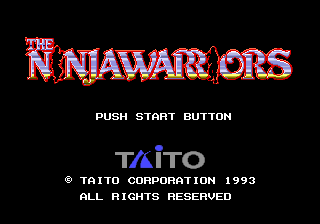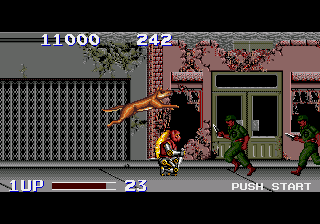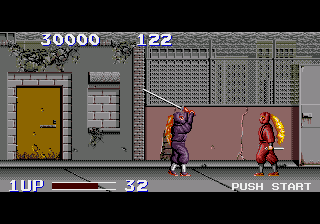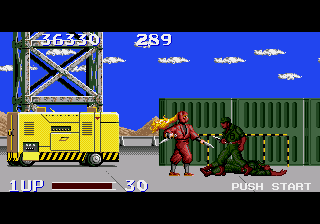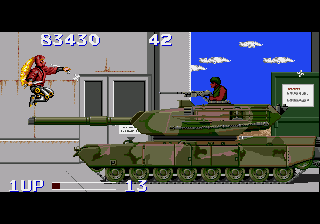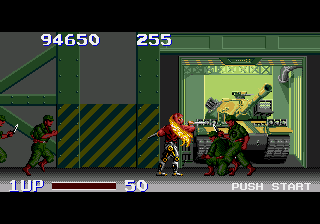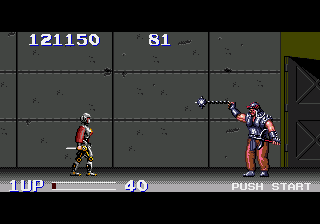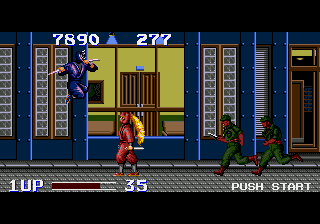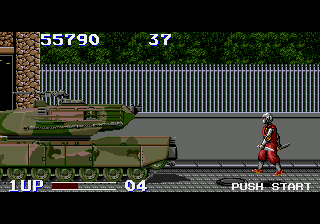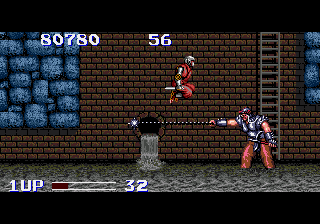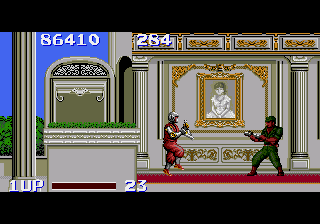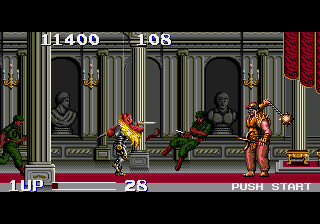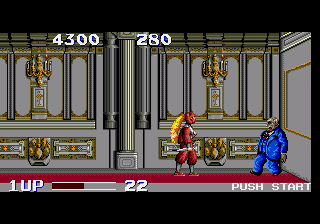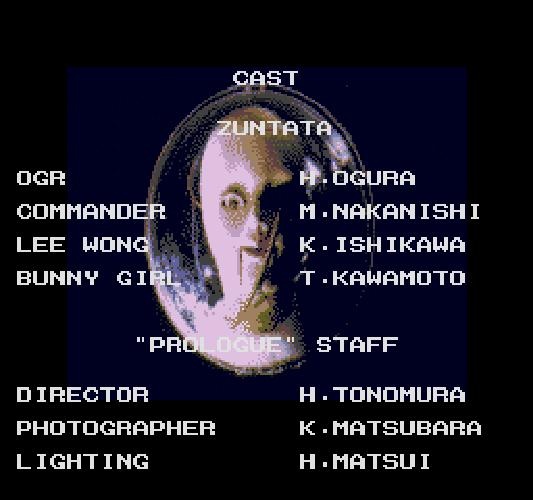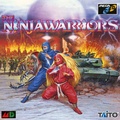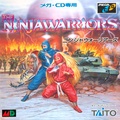Difference between revisions of "The Ninja Warriors"
From Sega Retro
m (Text replacement - "Pony Canyon Inc." to "Pony Canyon Inc.") |
|||
| (47 intermediate revisions by 9 users not shown) | |||
| Line 1: | Line 1: | ||
{{Bob | {{Bob | ||
| bobscreen=NinjaWarriors title.png | | bobscreen=NinjaWarriors title.png | ||
| − | |||
| − | |||
| publisher=[[Taito]] | | publisher=[[Taito]] | ||
| − | | developer= | + | | developer=[[Aisystem Tokyo]] |
| system=[[Sega Mega-CD]] | | system=[[Sega Mega-CD]] | ||
| − | |||
| sounddriver= | | sounddriver= | ||
| peripherals= | | peripherals= | ||
| players=1-2 | | players=1-2 | ||
| − | | genre=Action | + | | genre=Action{{ref|https://web.archive.org/web/20190610175627/https://sega.jp/fb/segahard/mcd/soft_licensee.html}} |
| − | | releases={{ | + | | originaldevelopers=[[Taito]] |
| − | | mcd_date_jp=1993-03-12 | + | | originalsystem=Arcade Boards |
| + | | releases={{releasesMCD | ||
| + | | mcd_date_jp=1993-03-12{{ref|https://web.archive.org/web/20190610175627/https://sega.jp/fb/segahard/mcd/soft_licensee.html}} | ||
| mcd_code_jp=T-11024 | | mcd_code_jp=T-11024 | ||
| mcd_rrp_jp=7,800 | | mcd_rrp_jp=7,800 | ||
}} | }} | ||
| + | | otherformats={{NonSega|Arcade|Amiga|CPC|ST|C64|Spectrum|PCE}} | ||
}} | }} | ||
| − | + | '''''{{PAGENAME}}''''' (ニンジャウォーリアーズ) is a beat-'em-up originally developed by [[Taito]] for the arcades. It was brought to the [[Sega Mega-CD]] in 1993 exclusively for Japan. | |
| − | + | The game was previously announced for the [[Sega Mega Drive]] in 1990{{magref|bemega|1990-06|71}}, but failed to materialise. A US version also appears to have been planned for December 1993{{magref|megaplay|0406|77}}. | |
| − | + | ==Story== | |
| − | + | The game is set in a dystopian future where Banglar, the President of the United States in 1993, has declared martial law nationwide. A group of anarchist scientists led by Mulk decide that it is time to revolt against the government. Knowing full well that fighting the military themselves would be suicidal, the scientists create two powerful androids to carry out the mission for them. The robots, code-named "Kunoichi" (red female) and "Ninja" (blue male), are sent by the scientists to end Banglar's tyranny once and for all. | |
| − | + | ==Gameplay== | |
| + | The game is a side-scrolling beat-'em-up. It can be played alone or with another player. Players take control of Kunoichi or Ninja and fight wave after wave of Banglar forces. Both characters play identically. The ninjas move with {{left}} and {{right}} and jump with {{up}}. They crouch with {{down}} and can walk while crouching with {{downleft}} and {{downright}}. Some stages have stairs, which are ascended with {{upleft}} and {{upright}} and descended with {{downleft}} and {{downright}}. The controls can be changed in the game options, which includes mappings that change jump to {{C}}. | ||
| − | == | + | The ninjas attack with a short-range kunai slash with {{A}}. Holding {{A}} guards, which can deflect certain attacks. Jumping while guarding somersaults. The ninjas can also throw long-range shurikens with {{B}}. The shurikens are limited in supply; some of the tougher enemies reward the player with 5 shurikens when defeated. |
| − | {{ | + | |
| − | | | + | The ninjas have health meters that empty as they take damage from foes. As their health goes down, their skin and clothing tears away, revealing the robots underneath. The ninjas are destroyed after losing all of their health, but they can be revived if the player has continues remaining. Stages are also timed, and the ninjas are destroyed if time runs out. The ninjas start over with full health, 30 shurikens, and 300 seconds of time at the beginning of each stage and after reviving. |
| − | | | + | |
| − | + | ===Stages=== | |
| − | | | + | {{InfoTable|imagewidths=320| |
| − | | | + | {{InfoRow |
| − | + | | title=Slums | |
| − | + | | screenshot=Ninja Warriors, Stage 1.png | |
| − | | | + | | screenshot2=Ninja Warriors, Stage 1 Boss.png |
| − | | | + | | tabs=yes |
| − | | | + | | desc= |
| − | + | }} | |
| − | + | {{InfoRow | |
| − | + | | title=Military Base | |
| − | | | + | | screenshot=Ninja Warriors, Stage 2.png |
| − | | | + | | screenshot2=Ninja Warriors, Stage 2 Boss.png |
| + | | tabs=yes | ||
| + | | desc= | ||
| + | }} | ||
| + | {{InfoRow | ||
| + | | title=Hangar | ||
| + | | screenshot=Ninja Warriors, Stage 3.png | ||
| + | | screenshot2=Ninja Warriors, Stage 3 Boss.png | ||
| + | | tabs=yes | ||
| + | | desc= | ||
}} | }} | ||
| + | {{InfoRow | ||
| + | | title=Building Area | ||
| + | | screenshot=Ninja Warriors, Stage 4.png | ||
| + | | screenshot2=Ninja Warriors, Stage 4 Boss.png | ||
| + | | tabs=yes | ||
| + | | desc= | ||
| + | }} | ||
| + | {{InfoRow | ||
| + | | title=Underground Waterway | ||
| + | | screenshot=Ninja Warriors, Stage 5.png | ||
| + | | screenshot2=Ninja Warriors, Stage 5 Boss.png | ||
| + | | tabs=yes | ||
| + | | desc= | ||
| + | }} | ||
| + | {{InfoRow | ||
| + | | title=Banglar Mansion | ||
| + | | screenshot=Ninja Warriors, Stage 6.png | ||
| + | | screenshot2=Ninja Warriors, Stage 6 Boss 1.png | ||
| + | | screenshot3=Ninja Warriors, Stage 6 Boss 2.png | ||
| + | | tabs=yes | ||
| + | | desc= | ||
| + | }} | ||
| + | }} | ||
| + | |||
| + | ==Music and sound== | ||
| + | The game features a soundtrack composed by [[Taito]]'s in-house band [[Zuntata]]. The game includes both the arcade version's soundtrack as well as a new arranged soundtrack. An exclusive Zuntata mode was also included, which is basically a movie scene that explains the game's backstory. Members of Zuntata served as actors. | ||
| + | |||
| + | ==Versions== | ||
| + | The original arcade game was released in 1987 and used a three-screen setup (three 288x224 screens arranged in a horizontal line like with the ''Darius'' games). The game was ported to the [[PC Engine]] and Mega-CD as well as various personal computers: the [[Amiga]], [[Atari ST]], [[Commodore 64]], [[Amstrad CPC]], and [[ZX Spectrum]]. The ports of the game use a letterboxed game window to emulate the wide view of the arcade version. The Mega-CD is considered the most faithful port. | ||
| + | |||
| + | The game was remade as ''The Ninja Warriors Again'' for the [[Super NES]] in 1994. It was released as simply ''The Ninja Warriors'' in Western regions. This version differs significantly from the arcade game and its ports. | ||
| + | |||
| + | ==Production credits== | ||
| + | {{multicol| | ||
| + | {{creditstable| | ||
| + | {{creditsheader|Cast}} | ||
| + | *'''Zuntata''' | ||
| + | **'''OGR:''' [[Hisayoshi Ogura|H.Ogura]] | ||
| + | **'''Commander:''' [[Munehiro Nakanishi|M.Nakanishi]] | ||
| + | **'''Lee Wong:''' [[Katsuhisa Ishikawa|K.Ishikawa]] | ||
| + | **'''Bunny Girl:''' [[Tamayo Kawamoto|T.Kawamoto]] | ||
| + | {{creditsheader|"Prologue" Staff}} | ||
| + | *'''Director:''' H.Tonomura | ||
| + | *'''Photographer:''' K.Matsubara | ||
| + | *'''Lighting:''' H.Matsui | ||
| + | *'''Music:''' [[Hisayoshi Ogura|H.Ogura]], [[Tamayo Kawamoto|T.Kawamoto]] | ||
| + | *'''Photo Design:''' [[Munehiro Nakanishi|M.Nakanishi]] | ||
| + | *'''Object Design:''' H.Takahagi, M.Ogata | ||
| + | *'''Screen Play:''' Y.Watanabe, [[Katsuhisa Ishikawa|K.Ishikawa]] | ||
| + | *'''Make-Up:''' Y.Chika | ||
| + | *'''Sound Engineer:''' K.Ohnui | ||
| + | *'''Sound Effect:''' [[Katsuhisa Ishikawa|K.Ishikawa]], H.Takahagi | ||
| + | *'''Special Thanks:''' Office Misumi, Kiryo Video Inc., Take Off, Noah-Project | ||
| + | | source=In-game credits (Zuntata Mode) | ||
| + | | pdf=NinjaWarriors MCD JP SSCredits zuntata.pdf | ||
| + | | console=MCD | ||
| + | }} | ||
| + | |||
| + | {{creditstable| | ||
| + | {{creditsheader|The Crew}} | ||
| + | *'''Produced by:''' Yoshio Imamura | ||
| + | *'''Directed by:''' Takashi Shiokawa | ||
| + | *'''Written by:''' [[Hiroshi Tsujino|Onijust]] | ||
| + | *'''Director of Software:''' Mutsushige Tsuji | ||
| + | *'''Character Designers:''' Shrine, Masayuki Suzuki, Yoko Gotan, Satomi Yokose | ||
| + | *'''Sound Software:''' Daikoku Hisaya | ||
| + | *'''Music Composed by:''' [[Hisayoshi Ogura]] (Zuntata) | ||
| + | *'''Drama Music Composed by:''' [[Tamayo Kawamoto]] (Zuntata) | ||
| + | *'''Music Arranged by:''' Junichi Kawaguchi | ||
| + | *'''Synthesizer Manipulated by:''' [[Hiroshi Sukegawa]], [[Teruo Konishi]], [[Katsuhisa Ishikawa]] (Zuntata) | ||
| + | *'''Engineered by:''' Masao Saotome, Kazuyuki Ohnui (Zuntata) | ||
| + | *'''Musicians''' | ||
| + | **'''Drums:''' Atsuo Okamoto | ||
| + | **'''Bass:''' Naoki Watanabe | ||
| + | **'''Guitar:''' Takashi Masuzaki | ||
| + | **'''Tsugaru-Shamisen:''' Katsunari Sawada | ||
| + | *'''Game Checker:''' Kazuhiko Sugiyama, Tatsuya Kitazawa, Yoichi Sato | ||
| + | *'''Special Thanks:''' Keishi Itoh, Yuji Koga, Takahisa Horimoto, Tohru Kawaishi, Makoto Saitoh, [[Pony Canyon Inc.]], [[Scitron & Art Inc.]] | ||
| + | *'''Game Designed by:''' Eiji Takeshima | ||
| + | :'''© [[Taito|Taito Corporation]] 1993 All Rights Reserved''' | ||
| + | | source=In-game credits (Ending) | ||
| + | | pdf=Ninja Warriors MCD credits.pdf | ||
| + | | console=MCD | ||
| + | }} | ||
| + | }} | ||
| + | |||
| + | ==Digital manuals== | ||
| + | <gallery> | ||
| + | NinjaWarriors MCD MDMini2 manual.pdf|Mega Drive Mini 2 US/EU manual | ||
| + | NinjaWarriors MCD JP MDMini2 manual.pdf|Mega Drive Mini 2 JP manual | ||
| + | </gallery> | ||
| + | |||
| + | ==Magazine articles== | ||
| + | {{mainArticle|{{PAGENAME}}/Magazine articles}} | ||
| + | |||
| + | ==Physical scans== | ||
| + | {{ratings|MCD}} | ||
{{Scanbox | {{Scanbox | ||
| console=Mega-CD | | console=Mega-CD | ||
| Line 50: | Line 157: | ||
| back=NinjaWarriors MCD JP Box Back.jpg | | back=NinjaWarriors MCD JP Box Back.jpg | ||
| square=yes | | square=yes | ||
| − | | disc= | + | | disc=TheNinjaWarriors MCD JP Disc.jpg |
}} | }} | ||
| − | {{ | + | ==Technical information== |
| + | {{mainArticle|{{PAGENAME}}/Technical information}} | ||
| + | |||
| + | ==References== | ||
| + | {{NECRetro|italics=yes}} | ||
| + | <references/> | ||
| + | |||
| + | {{NinjaWarriorsOmni}} | ||
| + | {{TheTitle}} | ||
| + | [[Category:Mega Drive Mini 2 games]] | ||
Latest revision as of 04:43, 18 November 2024
| The Ninja Warriors | ||||||||||
|---|---|---|---|---|---|---|---|---|---|---|
| System(s): Sega Mega-CD | ||||||||||
| Publisher: Taito | ||||||||||
| Developer: Aisystem Tokyo | ||||||||||
| Original system(s): Arcade Boards | ||||||||||
| Developer(s) of original games: Taito | ||||||||||
| Genre: Action[1] | ||||||||||
| Number of players: 1-2 | ||||||||||
| ||||||||||
|
The Ninja Warriors (ニンジャウォーリアーズ) is a beat-'em-up originally developed by Taito for the arcades. It was brought to the Sega Mega-CD in 1993 exclusively for Japan.
The game was previously announced for the Sega Mega Drive in 1990[2], but failed to materialise. A US version also appears to have been planned for December 1993[3].
Contents
Story
The game is set in a dystopian future where Banglar, the President of the United States in 1993, has declared martial law nationwide. A group of anarchist scientists led by Mulk decide that it is time to revolt against the government. Knowing full well that fighting the military themselves would be suicidal, the scientists create two powerful androids to carry out the mission for them. The robots, code-named "Kunoichi" (red female) and "Ninja" (blue male), are sent by the scientists to end Banglar's tyranny once and for all.
Gameplay
The game is a side-scrolling beat-'em-up. It can be played alone or with another player. Players take control of Kunoichi or Ninja and fight wave after wave of Banglar forces. Both characters play identically. The ninjas move with ![]() and
and ![]() and jump with
and jump with ![]() . They crouch with
. They crouch with ![]() and can walk while crouching with
and can walk while crouching with ![]() and
and ![]() . Some stages have stairs, which are ascended with
. Some stages have stairs, which are ascended with ![]() and
and ![]() and descended with
and descended with ![]() and
and ![]() . The controls can be changed in the game options, which includes mappings that change jump to
. The controls can be changed in the game options, which includes mappings that change jump to ![]() .
.
The ninjas attack with a short-range kunai slash with ![]() . Holding
. Holding ![]() guards, which can deflect certain attacks. Jumping while guarding somersaults. The ninjas can also throw long-range shurikens with
guards, which can deflect certain attacks. Jumping while guarding somersaults. The ninjas can also throw long-range shurikens with ![]() . The shurikens are limited in supply; some of the tougher enemies reward the player with 5 shurikens when defeated.
. The shurikens are limited in supply; some of the tougher enemies reward the player with 5 shurikens when defeated.
The ninjas have health meters that empty as they take damage from foes. As their health goes down, their skin and clothing tears away, revealing the robots underneath. The ninjas are destroyed after losing all of their health, but they can be revived if the player has continues remaining. Stages are also timed, and the ninjas are destroyed if time runs out. The ninjas start over with full health, 30 shurikens, and 300 seconds of time at the beginning of each stage and after reviving.
Stages
| Slums | |
|---|---|
| Military Base | |
| Hangar | |
| Building Area | |
| Underground Waterway | |
| Banglar Mansion | |
Music and sound
The game features a soundtrack composed by Taito's in-house band Zuntata. The game includes both the arcade version's soundtrack as well as a new arranged soundtrack. An exclusive Zuntata mode was also included, which is basically a movie scene that explains the game's backstory. Members of Zuntata served as actors.
Versions
The original arcade game was released in 1987 and used a three-screen setup (three 288x224 screens arranged in a horizontal line like with the Darius games). The game was ported to the PC Engine and Mega-CD as well as various personal computers: the Amiga, Atari ST, Commodore 64, Amstrad CPC, and ZX Spectrum. The ports of the game use a letterboxed game window to emulate the wide view of the arcade version. The Mega-CD is considered the most faithful port.
The game was remade as The Ninja Warriors Again for the Super NES in 1994. It was released as simply The Ninja Warriors in Western regions. This version differs significantly from the arcade game and its ports.
Production credits
- Zuntata
- OGR: H.Ogura
- Commander: M.Nakanishi
- Lee Wong: K.Ishikawa
- Bunny Girl: T.Kawamoto
- Director: H.Tonomura
- Photographer: K.Matsubara
- Lighting: H.Matsui
- Music: H.Ogura, T.Kawamoto
- Photo Design: M.Nakanishi
- Object Design: H.Takahagi, M.Ogata
- Screen Play: Y.Watanabe, K.Ishikawa
- Make-Up: Y.Chika
- Sound Engineer: K.Ohnui
- Sound Effect: K.Ishikawa, H.Takahagi
- Special Thanks: Office Misumi, Kiryo Video Inc., Take Off, Noah-Project
- Produced by: Yoshio Imamura
- Directed by: Takashi Shiokawa
- Written by: Onijust
- Director of Software: Mutsushige Tsuji
- Character Designers: Shrine, Masayuki Suzuki, Yoko Gotan, Satomi Yokose
- Sound Software: Daikoku Hisaya
- Music Composed by: Hisayoshi Ogura (Zuntata)
- Drama Music Composed by: Tamayo Kawamoto (Zuntata)
- Music Arranged by: Junichi Kawaguchi
- Synthesizer Manipulated by: Hiroshi Sukegawa, Teruo Konishi, Katsuhisa Ishikawa (Zuntata)
- Engineered by: Masao Saotome, Kazuyuki Ohnui (Zuntata)
- Musicians
- Drums: Atsuo Okamoto
- Bass: Naoki Watanabe
- Guitar: Takashi Masuzaki
- Tsugaru-Shamisen: Katsunari Sawada
- Game Checker: Kazuhiko Sugiyama, Tatsuya Kitazawa, Yoichi Sato
- Special Thanks: Keishi Itoh, Yuji Koga, Takahisa Horimoto, Tohru Kawaishi, Makoto Saitoh, Pony Canyon Inc., Scitron & Art Inc.
- Game Designed by: Eiji Takeshima
- © Taito Corporation 1993 All Rights Reserved
Digital manuals
Magazine articles
- Main article: The Ninja Warriors/Magazine articles.
Physical scans
| Sega Retro Average | |||||||||||||||||||||||||||||||||||||||||||||||||||||||||||||||||||||||||||||||
|---|---|---|---|---|---|---|---|---|---|---|---|---|---|---|---|---|---|---|---|---|---|---|---|---|---|---|---|---|---|---|---|---|---|---|---|---|---|---|---|---|---|---|---|---|---|---|---|---|---|---|---|---|---|---|---|---|---|---|---|---|---|---|---|---|---|---|---|---|---|---|---|---|---|---|---|---|---|---|---|
|
| 53 | |
|---|---|
| Based on 15 reviews | |
Technical information
- Main article: The Ninja Warriors/Technical information.
References
NEC Retro has more information related to The Ninja Warriors
|
- ↑ 1.0 1.1 https://sega.jp/fb/segahard/mcd/soft_licensee.html (Wayback Machine: 2019-06-10 17:56)
- ↑ Beep! MegaDrive, "June 1990" (JP; 1990-05-08), page 71
- ↑ 3.0 3.1 Mega Play, "December 1993" (US; 1993-1x-xx), page 77
- ↑ File:NinjaWarriors MCD JP SSCredits zuntata.pdf
- ↑ File:Ninja Warriors MCD credits.pdf
- ↑ Beep! MegaDrive, "March 1993" (JP; 1993-02-08), page 24
- ↑ Consoles +, "Février 1993" (FR; 1993-0x-xx), page 70
- ↑ Computer & Video Games, "August 1993" (UK; 1993-07-15), page 90
- ↑ Electronic Gaming Monthly, "July 1993" (US; 1993-xx-xx), page 27
- ↑ Famitsu, "" (JP; 1993-03-05), page 1
- ↑ GameFan, "Volume 1, Issue 5: April 1993" (US; 1993-xx-xx), page 15
- ↑ Hippon Super, "March 1993" (JP; 1993-02-04), page 39
- ↑ Mega, "August 1993" (UK; 1993-07-15), page 48
- ↑ Mega Action, "September 1993" (UK; 1993-08-12), page 24
- ↑ MegaTech, "June 1993" (UK; 1993-05-20), page 70
- ↑ Mean Machines Sega, "May 1993" (UK; 1993-04-24), page 44
- ↑ Sega Force Mega, "August 1993" (UK; 1993-06-24), page 40
- ↑ Sega Saturn Magazine, "September 1995" (JP; 1995-08-08), page 85
- ↑ Video Games, "1/94" (DE; 1993-12-19), page 51
| The Ninja Warriors | |
|---|---|
|
Main page | Magazine articles | Reception | Technical information | |
